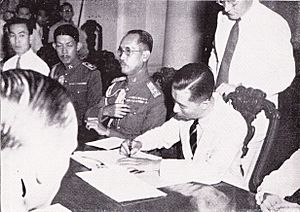Anglo-Thai Peace Treaty facts for kids
The Anglo-Thai Peace Treaty was a special agreement signed in Singapore on January 1, 1946. It officially ended the war between Thailand and the United Kingdom. This war had started on January 25, 1942, during World War II. Thailand had also declared war on the United States that same day. However, the U.S. government never signed a peace treaty with Thailand. This was because the U.S. didn't see Thailand's declaration of war as legal. They believed Japan had forced Thailand into it after the Japanese invasion of Thailand in December 1941.
The peace treaty became active on the day it was signed. It was officially recorded by the United Nations on August 23, 1951.
Contents
Why the Treaty Was Needed
During World War II, Thailand worked with the Empire of Japan. Because of this, Thailand gained some new lands. These lands became part of Thailand. In return, Japan could set up military bases in these areas and across Thailand.
Lands Gained by Thailand
Thailand took land from French Indochina after a short war with France in 1940-1941. It also gained land from British Malaya during Japan's attack in December 1941. On January 25, 1942, the Thai government declared war on the United States and the British Empire. Thailand's Northern Army also helped Japan invade British Burma, and part of that area was added to Thailand.
Secret Ties During the War
Even though Thailand was allied with Japan, some parts of the Thai government secretly worked with the Allied countries. They shared information with Allied spy services. When Japan surrendered in August 1945, the Thai government said it was never truly at war with the Western powers. They claimed Japan had forced them to declare war.
The U.S. government agreed with this idea. They treated Thailand as a friendly nation. However, the British government did not agree. They insisted that a peace treaty must be signed to officially end the war.
What the Treaty Changed
The main result of the peace treaty was that Thailand had to give back the lands it had taken. This included parts of the Shan States and four of the Unfederated Malay States. The British hoped for more changes, but the United States didn't want to punish Thailand too much. For example, the British could not make Thailand reduce the size of its army.
Key Agreements
- The treaty required Thailand to give up to 1.5 million tons of rice for free. Thailand had extra rice, and British Malaya needed it.
- It also stopped Thailand from building a canal across the Kra isthmus without British permission. This rule weakened the power of the Thai government at the time, led by Pridi Banomyong.
After the treaty was signed, the United States and Britain started talking to Thailand again on January 5. The next day, Thailand held a general election. The U.S. also loaned Thailand $10,000,000 to help rebuild its transportation system, which had been damaged by American bombing. Thailand officially joined the United Nations on December 16, 1946.
A separate peace treaty was signed between Australia and Thailand on April 3, 1946. This was needed because Australia had declared war on Thailand on March 2, 1942.
Sources


